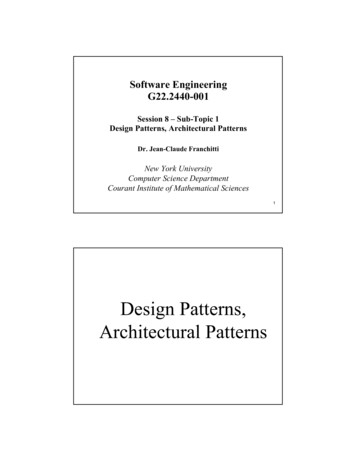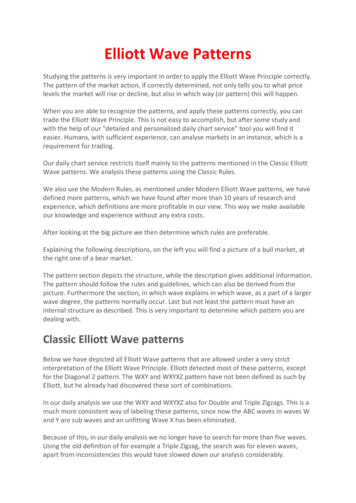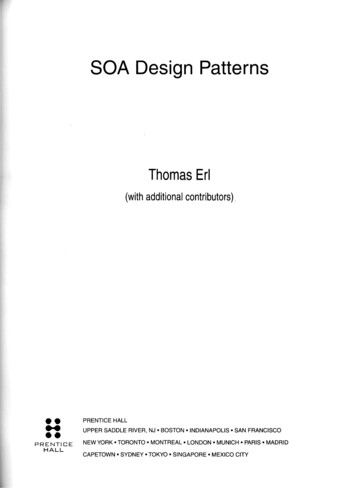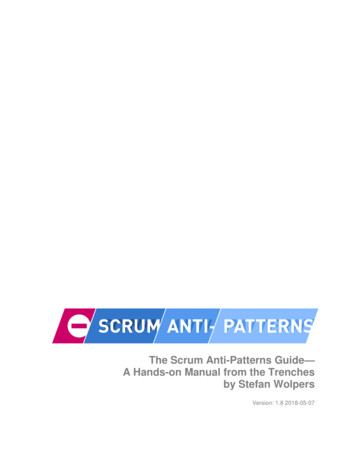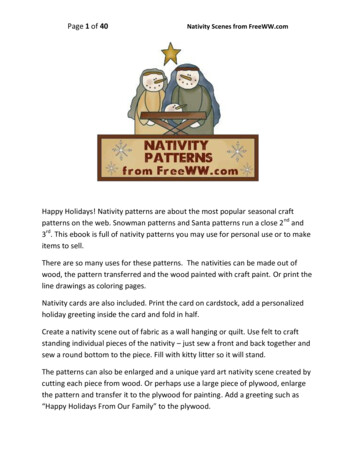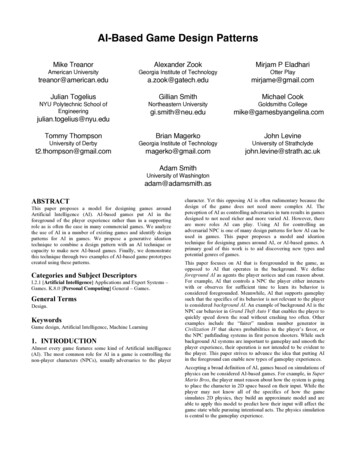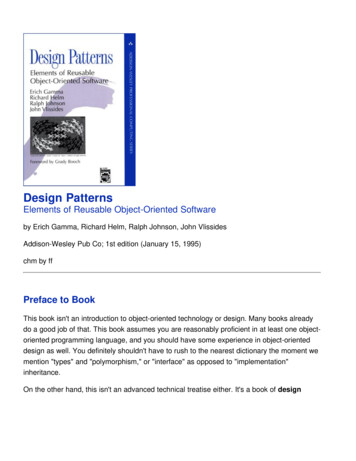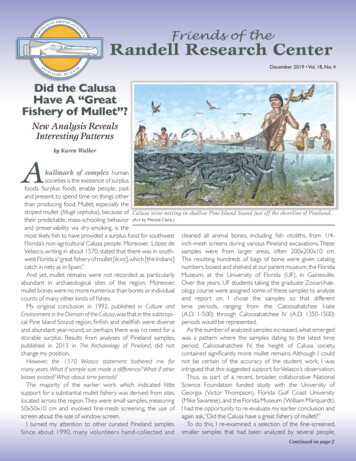
Transcription
R C E C O L A H I S T O R Y Y O G G Y L O E O H AFriends of theRandell Research Center A S W E L E A R N , W E T E A C H December 2019 Vol. 18, No. 4Did the CalusaHave A “GreatFishery of Mullet”?New Analysis RevealsInteresting PatternsAby Karen Walkerhallmark of complex humansocieties is the existence of surplusfoods. Surplus foods enable people, pastand present, to spend time on things otherthan producing food. Mullet, especially thestriped mullet (Mugil cephalus), because of Calusa seine-netting in shallow Pine Island Sound just off the shoreline of Pineland.their predictable, mass-schooling behavior (Art by Merald Clark.)and preservability via dry-smoking, is themost likely fish to have provided a surplus food for southwest cleaned all animal bones, including fish otoliths, from 1/4Florida’s non-agricultural Calusa people. Moreover, López de inch-mesh screens during various Pineland excavations. TheseVelasco, writing in about 1570, stated that there was in south- samples were from larger areas, often 200x200x10 cm.west Florida a “great fishery of mullet [licias], which [the Indians] The resulting hundreds of bags of bone were given catalognumbers, boxed and shelved at our parent museum, the Floridacatch in nets as in Spain.”And yet, mullet remains were not recorded as particularly Museum, at the University of Florida (UF), in Gainesville.abundant in archaeological sites of the region. Moreover, Over the years, UF students taking the graduate Zooarchaemullet bones were no more numerous than bones or individual ology course were assigned some of these samples to analyzeand report on. I chose the samples so that differentcounts of many other kinds of fishes.My original conclusion in 1992, published in Culture and time periods, ranging from the Caloosahatchee I-lateEnvironment in the Domain of the Calusa, was that in the subtropi- (A.D. 1-500) through Caloosahatchee IV (A.D. 1350-1500)cal Pine Island Sound region, finfish and shellfish were diverse periods would be represented.As the number of analyzed samples increased, what emergedand abundant year-round, so perhaps there was no need for astorable surplus. Results from analyses of Pineland samples, was a pattern where the samples dating to the latest timepublished in 2013 in The Archaeology of Pineland, did not period, Caloosahatchee IV, the height of Calusa society,contained significantly more mullet remains. Although I couldchange my position.However, the 1570 Velasco statement bothered me for not be certain of the accuracy of the student work, I wasmany years. What if sample size made a difference? What if other intrigued that this suggested support for Velasco’s observation.Thus, as part of a recent, broader, collaborative Nationalbiases existed? What about time periods?The majority of the earlier work which indicated little Science Foundation funded study with the University ofsupport for a substantial mullet fishery was derived from sites Georgia (Victor Thompson), Florida Gulf Coast Universitylocated across the region.They were small samples, measuring (Mike Savarese), and the Florida Museum (William Marquardt),50x50x10 cm and involved fine-mesh screening, the use of I had the opportunity to re-evaluate my earlier conclusion andagain ask, “Did the Calusa have a great fishery of mullet?”screen about the size of window screen.To do this, I re-examined a selection of the fine-screened,I turned my attention to other curated Pineland samples.Since about 1990, many volunteers hand-collected and smaller samples that had been analyzed by several people,Continued on page 2
Continued from page 1including myself, and another selection ofthe coarse-screened, larger samplesanalyzed by students. Samples came fromPineland, Mound Key, and other sites.Theoverall result was that re-analysis resultedin increased numbers of identified mulletbones (NISP: Number of IdentifiedSpecimens) and number of individualmullets (MNI: Minimum Number ofIndividuals). This was true also for thepercentage of mullet remains relative toall fishes.Interestingly, though, theMound Key results producedhigher mullet percentages forthe IV period with the latesttwo samples showing 35%NISP and 58% MNI as the highpercentages of mullet for allfishes consumed.Several sources of bias likely explainthe dampened mullet numbers of theearlier work. First, small sample andscreen sizes tend to produce largenumbers of remains from very smallfishes. One sample, for example, cancontain the bones of a couple ofhundred pinfish, which grow to onlyseveral inches long, but those of onlyone, much larger mullet, which deemphasizes the mullet. Balancing thesesamples with the larger, coarse-screenedsamples is needed.Analyst variability is anotherbias, even withlarger samples.Becausemulletvertebrae preserve well andthe thoracic ones are easiest toidentify, a common short-cutmethod of figuring MNI was used in theearlier work. An average of 11 thoracicvertebrae was used to represent oneindividual, and if 12 or more werefound, then 2 individuals were counted,and so on. And if one’s interpretivefocus is on MNI rather than NISP,then one might not bother identifyingthe remaining vertebrae, all of whichare also identifiable with close study.The shortcut results in undercountedspecimens (NISP).The nature of the mullet’s skeletonitself is likely another factor in earlierresults. In many fishes, the highly diagnostic elements of dentaries, premaxillae,and otoliths are frequently foundand identified, accounting for manyMNIs. Mullet mouthparts and otoliths,however, are very fragile and rarelyrecovered, especially by the coarserscreens. Also, the mullet atlas is unlikethe classic fish atlas; it is similar in form toStriped mullet, Mugil cephalus, line drawingby Merald Clark.other vertebrae and is easily missed.Thus, the re-analysis demonstrates thatmullet remains were underrepresentedin the earlier work. It also confirms thepattern of more mullet during theCaloosahatchee IV time period. But with14% NISP and 23% MNI being the “high”percentages of mullet for all fishesconsumed at Pineland, these numbers donot translate to a “great fishery of mullet.”Interestingly, though, the Mound Keyresults produced higher mullet percentages for the IV period with the latest twosamples showing 35% NISP and 58%MNI as the high percentages of mullet forall fishes consumed. Although moreanalyzed samples in the future may alterthis view, for now it appears that the“great mullet fishery” of the Calusa mayhave been a late phenomenon and onecentered at Mound Key more-so than atPineland.New and Renewing Friends of the RRCOctober 31, 2019 to November 10, 2019Please let us know of any errors or omissions.Thank you for your support.Supporting Members( 1,000- 4,999)Chris & Gayle BundschuDon & Dawn MaranoContributing Members( 100- 499)Bill & Mary CyzewskiMonika JenningsJanice KempRose & Gary KingJanet LevyAlan May & Ann TippitRandal L. WalkerDick & Becky WernerFamily MembersBoca Grande Historical SocietyLinda & Robert Bohacek2 Randell Research CenterMr. & Mrs. Wm. BroJoel & Christina BuntinDusty & Rose CarpenterNeil EricksonYan FernandezEllen GartenJessica GoletzNancy GreenLarkin & Barbara HosmerRufus Lemaire & Sherri TalleySusan McGuire & Jim DownerNarrie E. MagturoCyndi & Jeff MudgettRegina PoppellBetty SeidelGabriele SolterraSteven & Susan TutkoIndividual MembersLisl ArmstrongGwenyth F. BerryGeorge CarpenterCarolyn M. EmerickCarolyn HernandezThe Matlacha HookersBeverly MuldoonTony PietrofesaTammy RaverLaura StaleyOther GiftsMs. Jane Johnston in honor of Barbara BoltonDello JoiJennifer Workman Lessinger and Family inhonor of Dick WorkmanGloria Sajgo in honor of Robin Brown
Last Parcel of Land on Mound Key Bought by Lee CountyIsland in Estero Bay was once Capital of the Calusa Nationby Bill MarquardtPedro Menéndez de Avilés, appointedby the King of Spain to advance interests inFlorida, set foot on Mound Key with aformidable entourage of some 20 officers,200 soldiers, flag bearers, and musicians. Itwas winter, 1566, and Menéndez had beeninvited to dinner in the palatial home ofCalusa King Caalus, the undisputed ruler ofSouth Florida. Pipers played and drummersdrummed as the Spaniards marched to thetop of a 30-foot-tall hill dominated by astructure that could hold 2,000 people.Menéndez and the officers and musiciansentered, but – wary of betrayal – Menéndezordered his soldiers to remain outside withthe fuses of their portable matchlockcannons smoldering.Mound Key seen from the air in 1994. (Photo by Corbett Torrence.)remains of the Calusaking’s house on Mound 1;the site of Fort San Antónde Carlos;and engineeredwatercourts that servedto capture and store fishthat supported theCalusa population.Now, more than 450years after the Spaniardsabandoned their fort andmission, on SeptemberCrew outlines edges of outer wall of Fort San Antón de Carlos,17, 2019, the Lee County2017. (Photo by Victor Thompson.)Commission voted tobuy the last privatelyOutside the palace, 500 young Calusa owned property on Mound Key, the Calusagirls sang joyous songs. Inside, gifts were capital. The county’s 20/20 conservationexchanged and diplomatic speeches were program will pay 860,000 for the McGeeoffered. The Calusa brought a sizable feast property, the last 9.5 acres in privateof fish and shellfish, the Spaniards contri- ownership. Most of the 113-acre island hasbuted honey, biscuits, wine, and quince. been owned by the state since the 1960s.An uneasy alliance was arranged, andThe parcel contains a substantial portionby 1567 a fort and mission known as and the mouth of the great canal; both ofSan Antón de Carlos had been established. the massive water courts; intact ridgesSpanish ambitions went unrealized, above the courts that reveal evidence ofhowever, and by June, 1569 they had mass food preparation during the heydaywithdrawn from the island.of the Calusa; a large part of Mound 2—Recent work by a team from the Florida location of the Spanish fort and mission—Museum, the University of Georgia, Florida and waterlogged deposits with preservaGulf Coast University, and Flagler College tion of organic materials such as wood,has resulted in the identification of the cordage, and netting. Logistically, the parcelis accessible from a sturdy dock built by theMcGees, and the ground is free of mostvegetation.Archaeological potential is exceptionallyhigh. The McGee brothers – Ted, Todd, andTim –carefully preserved the land, leavingartifacts in place on the surface and prohibiting digging in the deposits except bytrained professionals.Their parcel has beenused as a goat farm for many years, anddespite trepidation that the goats woulddestroy archaeological deposits, quite theopposite is true.The goats eat most of thevegetation on the ground and what theycan reach in the trees, but – unlike wildhogs – they do not dig beneath the surfacenor cause erosion damage. The result isan open landscape where topography isevident and remote-sensing techniquessuch as ground-penetrating radar can beemployed with ease.To learn more about ongoing work onMound Key, look for its Facebook site,or read past articles in this newsletter, available online at The following newsletters containmore on Mound Key: Vol. 13, No. 2;Vol. 14, No. 1; Vol. 15, No. 1; Vol. 15,No. 2; Vol. 16, No. 1; Vol. 16, No. 3.December 20193
R C E C O L A H I S T O R YFriends of the Y O G G Y L O E O H ARandell Research Center A S W E L E A R N , W E T E A C H PO Box 608Pineland, FL 33945-0608Non-profitOrganizationU.S. PostagePAIDPineland, FL33945Permit No. 26Forwarding Service RequestedNew Flag Pole forHistoric Post OfficeITHarbor History ToursReturn in 2020t gives us greathe Randell Research Centerpleasure tois partnering with Captiva Cruisesannounce theto offer five exciting Harborinstallation of a newHistory Boat Tours of Northernflag pole at thePine Island Sound each departingP i n e l a n d Po s ton a Tuesday from Pineland atOffice, replacing the12:30 p.m. The 2020 dates areby and learn about the fish housesworn and corrodedTuesdays, Jan. 7, Feb. 4 and 18, and Boatat Captiva Shoals on the Harborpole that stoodMarch 3 and 24.History Boat Tour. (Photo by Ron Mayhew.)through HurricanesThe 90-minute, round-trip willCharley and Irma.be aboard the Santiva, a stable how geologic processes worked toAndy Jendrusiak, RRC Groundskeeper,The Pinelandpontoon boat with shade over create the Pine Island estuary.raises the flag on the new flag pole heYour reservations and 35 perPo s t O f fi c e w a smost of the seats. Our narrator willinstalled at the Pineland Post Office.adultpayment are made (Photo by Bill Marquardt.)Until 1917, it wasTour of the Islands of Pine Island Captiva Cruises by calling at (239)located in a small building on a Calusa midden-moundSound: Their Geology, Archaeology, 472-5300. Car parking, check-inacross from where the Tarpon Lodge sits today. In 1924and History. You will learn about the and pre-trip orientation will be ator 1925, under postmaster Ruby Vance Gill, a stormsur pr ises encountered when n o o n o n t h e d a y o f y o u rwashed it away. Soon after, Ruby built a post officeWilson’s Cut was dredged, discover reser vation in the Classroom atjust west of her two-story home on Pineland Road. Itwhy the stories of Useppa Island Calusa Her itage Tr ail, 13810is unknown how long that structure stood, Pine Islandare a metaphor for all the islands, Waterfront Drive, Pineland, FL. Ifresident Florence Hiltbrand, inter viewed by authorlear n how myster ious islands you have questions, please callElaine Jordan, noted, “you could see the daylight allreceived their names, and explore Captiva Cruises, (239) 472-5300.the way through it”. The current buildingwas constructed in 1925, precisely when isGift Shop & Tour Information:uncertain. Buffered by a fringe of mangroves,(239) 283-2157the distinctive building has endured nine Editor: C indy BearSend questions or comments to:hurricanes and subsequent repairs. It is our Writers: Cindy BearRandell Research Centerhope the new pole, replacing the rusted one,Bill MarquardtPO Box 608does justice to the resilience of Pineland.Karen WalkerPineland, FL 33945-0608Production: GBS ProductionsTelephone: (239) 283-2062Email: rrc@flmnh.ufl.eduWebsite: www.floridamuseum.ufl.edu/rrcRRC News
Friends of the A Y O G R C I S G Y H T O R Y L O E C O L E O H ARandell Research Center A S W E L E A R N , W E T E A C H Pineland, Florida December 2019Phone 239-283-2062Email: rrc@flmnh.ufl.eduDear Friend,You are cordially invited to join, or renew your membership in, the RRC’s support society, Friends of the RandellResearch Center. All Friends of the RRC receive a quarterly newsletter and free admission to the Calusa HeritageTrail at Pineland. Supporters at higher levels are entitled to discounts on our books and merchandise, advance noticeof programs, and special recognition. Your continuing support is vital to our mission. It means more research, moreeducation, and continued site improvements at the Randell Research Center. Thank you.Sincerely,Cindy BearCo-DirectorRandell Research CenterPlease check the membership level you prefer, and send this form with your check payable toUniversity of Florida Foundation, to:Membership Coordinator Randell Research Center PO Box 608 Pineland, Florida 33945Permanent AddressNameAddress Supporter ( 1,000- 4,999): The above listing on annualdonor plaque at Pineland site Sustaining Members ( 5,000- 19,999), Benefactors( 20,000- 99,999), and Patrons ( 100,000 and above)receive all of the above complimentary RRC publications andspecial briefings from the Director.Photo by A. Bell. Individual ( 30) and Student ( 15): quarterly Newsletter andfree admission to Calusa Heritage Trail Family ( 50): The above advance notice on special events andprograms Contributor ( 100- 499): The above annual honor roll listing innewsletter 10% discount on RRC publications and merchandise S ponsor ( 500- 999): The above invitation to annualDirector’s tour and receptionCity / State / ZipcodeEmail addressSeasonal Address (so we can send you your newsletter while you are away)NameAddressCity / State / ZipcodeUse my seasonal address from to .(date)(date)For more information about establishing an endowment, creating a bequest or charitable remainder trust, or giving gifts of property or securities, please contactMarie Emmerson, Senior Director of Development, emmerson@ufl.edu, cell: 352-256-9614.The Randell Research Center is a program of the Florida Museum of Natural History, University of Florida.Thank you for your support.
Books, Videos, Cards, and RRC GearBOOKS ON SOUTHWEST FLORIDA’S ARCHAEOLOGY & HISTORYNUMBERORDEREDA Tour of the Islands of Pine Island Sound, Florida: Their Geology, Archaeology, and Historyby Denége Patterson. RRC Popular Series No. 2, softcover, full color, 29.95The Plant World of the Calusa: A View from Pinelandwritten and illustrated by Martha Kendall, RRC Popular Series No. 1, softcover, full color, SALE! 10.00The Calusa and Their Legacy: South Florida People and Their Environmentsby Darcie A. MacMahon and William H. Marquardt, U. Press of Florida, hardcover, 39.95The Archaeology of Pineland: A Coastal Southwest Florida Site Complex, A.D. 50-1710, edited byWilliam Marquardt and Karen Walker, Monograph 4, hardcover, 935 pages, 408 figures, 231 tables, bibliographic references, 125.00Discovering Florida: First-Contact Narratives from Spanish Expeditions along the Lower Gulf Coastedited and translated by John E. Worth, U. Press of Florida, softcover, 27.95The Florida Journals of Frank Hamilton Cushingedited by Phyllis E. Kolianos and Brent W. Weisman, University Press of Florida, hardcover 49.95The Archaeology of Useppa Islandedited by William H. Marquardt, Monograph 3, hardcover 35.00, softcover 20.00New Words, Old Songs: Understanding the Lives of Ancient Peoples inSouthwest Florida Through Archaeologyby Charles Blanchard, illustrated by Merald Clark, SALE! hardcover 10.00, softcover 5.00Fisherfolk of Charlotte Harbor, Floridaby Robert F. Edic, hardcover, 35.00Missions to the Calusaby John H. Hann, U. Press of Florida, hardcover, 35.00Randy Wayne White’s Ultimate Tarpon Book: The Birth of Big Game Fishingedited by Randy Wayne White and Carlene Fredericka Brennen. U. Press of Florida, softcover, 21.95Eyes of the Calusaby Holly Moulder, a historical novel for young readers, winner of the silver medal in young adult fiction from theFlorida Publisher’s Association, White Pelican Press, 8.95The Crafts of Florida’s First Peopleby Robin Brown, a step-by-step guide to making Florida Indian tools and containers (for ages 10 and up),Pineapple Press, softcover, 9.95Water from Stone: Archaeology and Conservation at Florida’s Springsby J. O’Donoughe. U. Press of Florida, hardcover, 74.95COST Florida Weather and Climateby J. Collins, R. Rohli and C. H. Paxton. U. Press of Florida, hardcover, 34.95 Sea Level Rise in Florida: Science, Impacts, and Optionsby A. C. Hine, D. P. Chambers, T. D. Clayton, M.R. Hafen and G. T. Mitchum. U. Press of Florida, hardcover, 34.95 CALUSA POSTCARDSImages from the Calusa Heritage TrailArt by Merald Clark, 4”-x-6” postcards, full-color, set of 11 cards, 4.95RRC postcardsArt by Patricia Randell, 4” x 6” black and white, set of 4, 2.00 RANDELL RESEARCH CENTER GEARRRC logo hat 21.95Calusa Heritage Trail T-shirts designed by Merald Clark:Specify size (S, M, L, XL) Seven Masks (black with white image, seven Calusa masks), 18.95 Total for items ordered:Friends of the RRC who give at the 100level or above may deduct 10% Discount: —Florida residents add sales tax:Shipping: Add 5.00 for first item, 1.00 for each additional item:TOTAL: To place order, make check payable toUniversity of Florida Foundation and mail to:Randell Research CenterPO Box 608Pineland, FL 33945.Questions? 239-283-2157E-mail: rrc@flmnh.ufl.eduName (please print):Mailing address (please print):Zip code (please print):
LEARN, E T E A C H Friends of the Randell Research Center December 2019 Vol. 18, No. 4 Calusa seine-netting in shallow Pine Island Sound just off the shoreline of Pineland. (Art by Merald Clark.) A hallmark of complex human societies is the existence of surplus foods. Surplus foods enable people, past and present, to spend time on .

